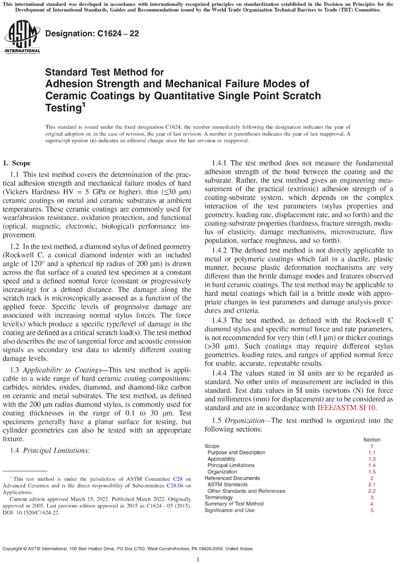Most recent
ASTM C1624-22
Standard Test Method for Adhesion Strength and Mechanical Failure Modes of Ceramic Coatings by Quantitative Single Point Scratch Testing
1.1This test method covers the determination of the practical adhesion strength and mechanical failure modes of hard (Vickers Hardness HV = 5 GPa or higher), thin (‰¤30 μm) ceramic coatings on metal and ceramic substrates at ambient temperatures. These ceramic coatings are commonly used for wear/abrasion resistance, oxidation protection, and functional (optical, magnetic, electronic, biological) performance improvement.
1.2In the test method, a diamond stylus of defined geometry (Rockwell C, a conical diamond indenter with an included angle of 120° and a spherical tip radius of 200 μm) is drawn across the flat surface of a coated test specimen at a constant speed and a defined normal force (constant or progressively increasing) for a defined distance. The damage along the scratch track is microscopically assessed as a function of the applied force. Specific levels of progressive damage are associated with increasing normal stylus forces. The force level(s) which produce a specific type/level of damage in the coating are defined as a critical scratch load(s). The test method also describes the use of tangential force and acoustic emission signals as secondary test data to identify different coating damage levels.
1.3Applicability to Coatings - This test method is applicable to a wide range of hard ceramic coating compositions: carbides, nitrides, oxides, diamond, and diamond-like carbon on ceramic and metal substrates. The test method, as defined with the 200 μm radius diamond stylus, is commonly used for coating thicknesses in the range of 0.1 to 30 μm. Test specimens generally have a planar surface for testing, but cylinder geometries can also be tested with an appropriate fixture.
1.4Principal Limitations:
1.4.1The test method does not measure the fundamental adhesion strength of the bond between the coating and the substrate. Rather, the test method gives an engineering measurement of the practical (extrinsic) adhesion strength of a coating-substrate system, which depends on the complex interaction of the test parameters (stylus properties and geometry, loading rate, displacement rate, and so forth) and the coating-substrate properties (hardness, fracture strength, modulus of elasticity, damage mechanisms, microstructure, flaw population, surface roughness, and so forth).
1.4.2The defined test method is not directly applicable to metal or polymeric coatings which fail in a ductile, plastic manner, because plastic deformation mechanisms are very different than the brittle damage modes and features observed in hard ceramic coatings. The test method may be applicable to hard metal coatings which fail in a brittle mode with appropriate changes in test parameters and damage analysis procedures and criteria.
1.4.3The test method, as defined with the Rockwell C diamond stylus and specific normal force and rate parameters, is not recommended for very thin (<0.1 μm) or thicker coatings (>30 μm). Such coatings may require different stylus geometries, loading rates, and ranges of applied normal force for usable, accurate, repeatable results.
1.4.4The values stated in SI units are to be regarded as standard. No other units of measurement are included in this standard. Test data values in SI units (newtons (N) for force and millimetres (mm) for displacement) are to be considered as standard and are in accordance with IEEE/ASTM SI 10.
1.5Organization - The test method is organized into the following sections:
1.6This standard does not purport to address all of the safety concerns, if any, associated with its use. It is the responsibility of the user of this standard to establish appropriate safety, health, and environmental practices and determine the applicability of regulatory limitations prior to use.
1.7This international standard was developed in accordance with internationally recognized principles on standardization established in the Decision on Principles for the Development of International Standards, Guides and Recommendations issued by the World Trade Organization Technical Barriers to Trade (TBT) Committee.
Content Provider
ASTM International [astm]






